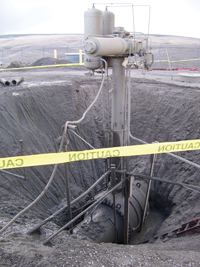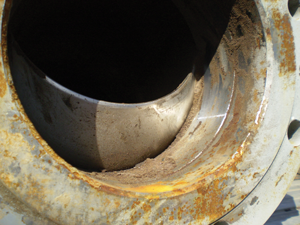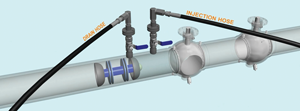Emergency Repair in Pipelines
Decades of innovation and ingenuity in the pipeline valve manufacturing industry have resulted in dozens of designs incorporating multiple body parts, top and bottom entry designs and sophisticated seat sealant systems.
#maintenance-repair #automation
Valve care product manufacturers and service companies continually invest in research and development to keep pace with this evolving industry. The result is that today, even if all conventional equipment fails, technology allows aggressive sealing procedures to occur.
NEW TECHNOLOGIES
Many valve manufacturers offer designs that allow for in-line repairs. Smaller diameter, three-piece ball valves can be swung out of the line by removing all but one corresponding bolt on each body flange, making seat ring access and replacement faster and simpler. Also, top-entry and bottom-entry valves allow technicians access to the seat rings or slips without physically removing the valve body from the pipeline.
In both cases, the pipeline section under repair needs to be completely isolated and depressurized before work can commence. This is an ideal scenario for the technician because there is no risk from trapped pressure release. But it can be a costly situation for an operator when unscheduled. Not only is there lost revenue from an unplanned shutdown, but also the cost of venting large sections of pipeline between critical valves. Some designs allow for stem seal repairs while the valve is online, but this requires great care and attention when executing to prevent accidents.
The most economically efficient method of maintaining pipeline integrity without having to shut down for repairs and maintenance is to temporarily seal a leaking valve with a synthetic-based valve sealing product. Conventional sealing might not be temporary and can actually prevent a valve from operating because of its design intent or because of organic additives, which tend to harden and set up in the presence of dry hydrocarbons such as natural gas. Synthetic sealants, however, are specifically designed for use in extreme operating conditions such as steam injection and heavy oil extraction, sour gas and other refined products. They won’t harden inside the valve’s sealant system and will remain pliable until washed away. An important note here is that, once the synthetic product is injected into the seat, it will only last for as long as the valve remains in one position. Once the valve cycles, some of the product will wash downstream and may need to be injected again.
EXTREME REPAIR
Some extreme cases require a technician to fill the valve body cavity with a heavy sealant that, because of passageway restrictions, wouldn’t otherwise pass through the injection and buried check fittings. This procedure is reserved for critical mainline ball and gate valves that must seal in an emergency. The operator can have a service crew ready to perform this procedure for a scheduled shutdown, but the logistics involved make this solution difficult to pull off in an emergency. Anyone who anticipates this situation should stock the proper volume of sealant for the valve in question to mitigate the delay in manufacturing and shipping a custom order. Large-diameter, mainline block valves require hundreds and sometimes thousands of pounds of product to fill the body cavity, especially gate valves with elongated body designs. Another important note is that having this volume of product manufactured for a special order can take days or weeks, which can delay day-to-day operations further.
This procedure is labor intensive and requires several trade experts who can perform hot tapping, line venting/draining, pipe cutting and welding, valve sealing, operator installation and new equipment commissioning. Once the assembly is installed and the line is drained of sealant, the new valve needs to be closely monitored.
Construction debris is the top reason for new valve leakage. To help with this situation, lubricant needs to be pumped through the seat sealant system before the valve is operated to ensure leftover debris is pushed out of the seat ring grooves and washed downstream to be collected by a cleaning pig.
PLAN FOR IT
The costs associated with this solution include contracting trade personnel, procuring sealing product and a new valve assembly, and the logistics of getting all of this to the site. However, when advanced planning is done so the repair corresponds with a scheduled outage, the solution is much more economical than risking an unplanned multi-million-dollar shutdown.
Jason Chisholm is marketing and communications coordinator for Sealweld (www.sealweld.com). Joe Pirkl is general manager and lead trainer for Sealweld. Reach them at jason@sealweld.com.
RELATED CONTENT
-
Gaskets Are Not Created Equal
Gaskets are near the bottom of the food chain of valve components; trim, body materials and packing seem to get a lot more press.
-
Safety-Relief Valve FAQ
Our company routinely receives inquiries from end users about their safety-relief valves.
-
Inspection and Maintenance Can Alleviate Supply Chain Woes
As industrial companies confront the challenges posed by global supply chain constraints, extra attention should be paid to maintenance as a strategy for minimizing the need for new equipment and components.












 Unloading large gate valve.jpg;maxWidth=214)
